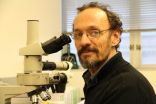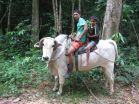(Press-News.org) MADISON, Wis. -- Frederick Crane was a researcher under David E. Green in the mid-1950s, during the early days of the University of Wisconsin-Madison Enzyme Institute, when he made his defining discovery.
The lab group was on a mission to determine, bit by bit, how mitochondria -- the power plants of cells -- generate the energy required to sustain life. What Crane found, a compound called coenzyme Q, was a missing piece of the puzzle and became a major part of the legacy of mitochondrial research at UW-Madison. But it was no accident.
"It was the result of a long train of investigation into a mechanism of, and compounds involved in, biological energy conversion," Crane wrote in a 2007 review article of his discovery.
Almost six decades later, that "long train" has grown even longer. Dave Pagliarini, a UW-Madison assistant professor of biochemistry, has established a new laboratory studying these dynamic organelles, the mitochondria. He recently published two studies shedding more light on coenzyme Q and how it's made, one in the Proceedings of the National Academy of Science (PNAS) in October and another today in Molecular Cell.
"Mitochondria are tiny structures in nearly all of our cells that are essential for producing our cellular energy and that house a wide array of metabolic processes," Pagliarini says. "When mitochondria don't work properly, many different human diseases can arise."
These include cerebellar ataxia, certain kidney diseases and severe childhood-onset multisystemic disease. Coenzyme Q deficiency is a hallmark of these diseases, but scientists aren't sure why.
"Nearly 60 years later, there is still much we don't know about how mitochondria make coenzyme Q and that has complicated our ability to target this pathway therapeutically," Pagliarini says.
The new studies, he says, are about two proteins known to be important in the coenzyme Q production pathway. Mutations in them lead to human disease. But before now, no one knew a thing about their biochemical functions.
One of these proteins is COQ9, and graduate student Danielle Lohman, co-lead author of the PNAS study, explains it's somehow involved in making coenzyme Q in mitochondria. The other lead author is Farhad Forouhar at Columbia University.
The study team -- which includes researchers from UW-Madison and other universities in the U.S. and Spain -- found COQ9 is essential for coenzyme Q production in mice. To study what it looks like, they created crystals of COQ9 in the lab and found it binds to compounds like coenzyme Q.
The team also found that COQ9 cooperates with another protein called COQ7, lending credence to the prevailing notion in the field that coenzyme Q is made through the actions of a collaborative complex of proteins.
Currently, Pagliarini and Lohman believe COQ9 may grab hold of immature coenzyme Q and help it along in its development, but more work is needed to find out. The current study gives them a place to start.
"We went from not knowing why this protein would be needed to make coenzyme Q, to having a model for what it might be doing," Lohman says.
Two other graduate students in Pagliarini's lab, Jonathan Stefely and Andrew Reidenbach, worked together to lead the Molecular Cell study of a human mitochondrial protein also involved in building coenzyme Q, called ADCK3.
"Like COQ9, there are patients with mutations in ADCK3 who have really bad cerebellar ataxia, described in the medical literature not too long ago," says Stefely.
Also like COQ9, ADCK3's biochemical function was previously unknown. The research team -- from UW-Madison, the University of Georgia and the University of San Diego -- similarly created a crystal of the protein and determined the protein family it's related to: the kinase superfamily. Craig Bingman, a research scientist at UW-Madison, performed the challenging crystal work.
While solving the crystal structure revealed the protein's genealogy, it also provided the researchers with information that could have implications for cancer and other cellular processes that may rely on the actions of this protein and its close relatives. It provides a platform for further discovery.
"It has some very specific and unique features that separate it from the rest of this kinase superfamily," says Reidenbach.
"We were also able to show the first enzymatic activity for ADCK3, which was a major milestone in this field," Stefely adds.
With these mitochondrial proteins and many others, much is still unknown. They represent an untapped resource, Pagliarini says, but the mining for answers is happening right here, where coenzyme Q was first found.
In his lab, Pagliarini is on a quest to describe the hundreds of mitochondrial proteins with functions yet unknown. With colleagues, he has amassed a collection of them in an inventory they've called the MitoCarta.
"I stumbled into mitochondrial biology early in my graduate career and spent my postdoctoral years systematically identifying new mitochondrial proteins" says Pagliarini. "Now, I am very interested in annotating the functions of these 'orphan' proteins."
For Pagliarini and his students -- the future of UW-Madison mitochondrial research -- the old, yet still-wide-open field of study offers plenty of opportunity for curiosity, and promise.
"It gives you a sense of wonder; for me, like all scientists, I just want to know how things work," says Lohman. "This seemed like fruit ripe for the picking."
INFORMATION:
Kelly April Tyrrell
ktyrrell2@wisc.edu
608-262-9772
Montréal, December 11, 2014 - Researchers in Montréal led by Jacques Drouin, D.Sc., uncovered a mechanism regulating dopamine levels in the brain by working on a mouse model of late onset Parkinson's disease. The study, conducted in collaboration with Dr. Rory A. Fisher from the Department of Pharmacology at the University of Iowa Carver College of Medicine, is published online today by the scientific journal PLoS Genetics.
Using gene expression profiling, a method to measure the activity of thousands of genes, researchers investigated dopaminergic neurons in ...
WEST LAFAYETTE, Ind. - A new method that creates large-area patterns of three-dimensional nanoshapes from metal sheets represents a potential manufacturing system to inexpensively mass produce innovations such as "plasmonic metamaterials" for advanced technologies.
The metamaterials have engineered surfaces that contain features, patterns or elements on the scale of nanometers that enable unprecedented control of light and could bring innovations such as high-speed electronics, advanced sensors and solar cells.
The new method, called laser shock imprinting, creates shapes ...
A new study led by researchers at University of California, San Diego School of Medicine finds that the brains of obese children literally light up differently when tasting sugar.
Published online in International Journal of Obesity, the study does not show a causal relationship between sugar hypersensitivity and overeating but it does support the idea that the growing number of America's obese youth may have a heightened psychological reward response to food.
This elevated sense of "food reward" - which involves being motivated by food and deriving a good feeling ...
PORTLAND, Ore. -- A large international group of scientists, including an Oregon Health & Science University neuroscientist, is publishing this week the results of a first-ever look at the genome of dozens of common birds. The scientists' research tells the story of how modern birds evolved after the mass extinction that wiped out dinosaurs and almost everything else on Earth 66 million years ago, and gives new details on how birds came to have feathers, flight and song.
The consortium of more than 200 scientists is publishing its findings nearly simultaneously this week ...
A team of researchers led by North Carolina State University has found that stacking materials that are only one atom thick can create semiconductor junctions that transfer charge efficiently, regardless of whether the crystalline structure of the materials is mismatched - lowering the manufacturing cost for a wide variety of semiconductor devices such as solar cells, lasers and LEDs.
"This work demonstrates that by stacking multiple two-dimensional (2-D) materials in random ways we can create semiconductor junctions that are as functional as those with perfect alignment" ...
Agricultural decisions made by our ancestors more than 10,000 years ago could hold the key to food security in the future, according to new research by the University of Sheffield.
Scientists, looking at why the first arable farmers chose to domesticate some cereal crops and not others, studied those that originated in the Fertile Crescent, an arc of land in western Asia from the Mediterranean Sea to the Persian Gulf.
They grew wild versions of what are now staple foods like wheat and barley along with other grasses from the region to identify the traits that make some ...
GAINESVILLE, Fla. --- Nature abhors a vacuum, which may explain the findings of a new study showing that bird evolution exploded 65 million years ago when nearly everything else on earth -- dinosaurs included -- died out.
The study is part of an ambitious project, published in today's issue of the journal Science, in which hundreds of scientists worldwide have decoded the avian genome.
Edward Braun, an evolutionary geneticist at the University of Florida and the UF Genetics Institute, is one of the key scientists who took part in this multi-year project that used nine ...
(Santa Barbara, Calif.) -- With more and more rainforest giving way to pasture and grazing land every year, the practice of cattle ranching in the Amazon has serious implications on a global scale. At the same time, however, it provides a degree of socioeconomic flexibility for Amazonian smallholders who simply can't survive on what the forest or agriculture provide.
In a paper published in the current issue of the journal Human Organization, UC Santa Barbara anthropologist Jeffrey Hoelle takes a look at the rise of cattle ranching in the Brazilian state of Acre and the ...
Astronomers using the Atacama Large Millimeter/submillimeter Array (ALMA) may have detected the dusty hallmarks of an entire family of Pluto-size objects swarming around an adolescent version of our own Sun.
By making detailed observations of the protoplanetary disk surrounding the star known as HD 107146, the astronomers detected an unexpected increase in the concentration of millimeter-size dust grains in the disk's outer reaches. This surprising increase, which begins remarkably far -- about 13 billion kilometers -- from the host star, may be the result of Pluto-size ...
COLUMBUS, Ohio - If dieting is on your New Year agenda, it might pay to be mindful of a study suggesting there is little hard evidence that mindfulness leads to weight loss.
Ohio State University researchers reviewed 19 previous studies on the effectiveness of mindfulness-based programs for weight loss. Thirteen of the studies documented weight loss among participants who practiced mindfulness, but all lacked either a measure of the change in mindfulness or a statistical analysis of the relationship between being mindful and dropping pounds. In many cases, the studies ...


